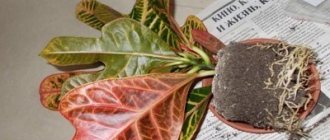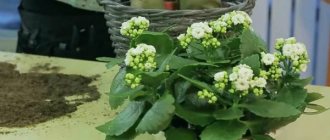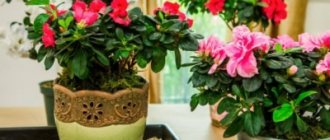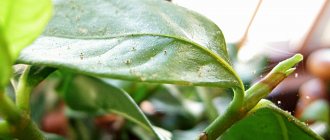Croton (or codiaum) is a houseplant distinguished by its unusual beauty.
The following types of Croton are very popular among gardeners: Motley, Petra, Excellent, Tamara.
At the same time, this is a very capricious flower that requires special care.
It should not be replanted more than once every 2-3 years.
Since replanting is difficult for , you need to know all the features of the process: when is the best time to carry it out, what kind of soil and pot is best to use, and much more.
Peculiarities
Croton is replanted once every 2-3 years ; in some cases, replanting is allowed after 4 years.
Croton should not be disturbed during the flowering period. Therefore, the optimal time for transplantation is March. It is at this time that the growing season begins.
Transplantation after purchase is very important for codiaum; it is best to do it as soon as possible.
The substrate in which the flower “lived” in the store and during transportation, at home, can lead to the leaves drying out and falling off, other Croton diseases, and even the death of the plant .
Croton is replanted for several reasons:
- becomes depleted over time and needs to be replaced;
- The root system develops and there is little room for it in the pot. Therefore, a sign that it is time to move a flower is the appearance of roots on the surface of the ground.
Each subsequent one should be 2-3 cm larger than the previous one . You should use plastic or clay ones.
Description
Croton (codium) is a perennial, decorative deciduous shrub of the Euphorbiaceae family. In its natural environment it can be found on the islands of the Pacific Ocean. And also in Northern Australia and Southeast Asia. The genus of crotons, according to various sources, contains from 17 to 1200 species, but only the variegated variety and its hybrids are grown at home.
Croton flower is a low shrub with large, leathery leaves. Depending on the variety, the plates are oblong-lanceolate, asymmetrical, or broadly ovoid in shape. Their tips can be pointed or blunt.
Young croton leaves are colored in light yellowish-green shades. But over time, they acquire a bright color and can be either dark green or red-burgundy. Moreover, regardless of the variety, there are bright veins or spots on the leaves.
Croton flowers have no aesthetic value. After all, small, inconspicuous buds, painted in cream shades, do not add attractiveness to the plant. In addition, they draw juices from the culture. Therefore, it is recommended to cut them out immediately, of course, if you are not going to propagate the plant by seed.
It is worth considering that croton is a poisonous flower. Its milky sap causes nausea, vomiting, stomach upset and contact dermatitis. Therefore, you need to wear gloves when caring for the plant. In addition, it is important to keep the flower pot out of the reach of children and pets.
Transplant instructions
The soil must first be prepared. Its composition depends on age.
For young plants, the soil for replanting consists of coarse river sand, leaf soil and turf soil, mixed in a ratio of 1:2:1. For an adult, the ratio is 1:3:1, respectively.
You can also use soil purchased at the store. It is recommended to add a little leaf soil to it Before planting, the soil should be shed with a weak solution of potassium permanganate and dried.
Drainage
must be placed at the bottom - expanded clay or clay shards. It should fill ¼ of the pot.
After preparing the pot and soil, you can begin replanting the croton:
Drainage is laid at the bottom , soil is poured on top. The earth is moistened and a depression is made in the center.
The croton is removed from the old one. You need to pull it out carefully . You cannot disassemble its roots and remove soil from them. The plant is transplanted together with a lump of earth.
The exception is a flower that is replanted after being purchased in a store. You need to shake off as much substrate as possible from the roots of such a croton. However, disassembling the roots is also not recommended;
An earthen ball with roots is placed in a recess in the new one and covered with the remains of the new soil. There should be no voids in the pot , so the earth is slightly pressed down;
The transplanted croton is watered. After transplantation high humidity , so it needs to be watered daily . also recommended to spray it with a spray bottle.
Seedlings (dividing the bush)
Sometimes the plant becomes too crowded in the pot. In this case, it is necessary to propagate the croton (plant).
The process is also recommended to coincide with the beginning of spring.
Pots with drainage and substrate (soil for young and adults) are pre-prepared. The day before transplanting, the plant is watered abundantly.
Seating is carried out as follows. The codiemu bush is removed and divided into several parts : the main plant and root children . A large bush is planted in a large pot with soil for an adult plant.
Small shoots are placed in small pots with soil for young flowers, covered with plastic wrap and placed in a warm place.
Briefly about croton
Another name for Codiaum is a perennial plant that belongs to the Euphorbiaceae family. Quite beautiful, but requires attention and knowledge of care features.
The name of the flower itself comes from the ancient Greek city and means “head”. There are several versions of the origin of this name, but many are inclined to believe that its authorship belongs to the botanist Georg Rumphis.
One of the most important questions that every gardener should ask himself when purchasing is: how to replant croton?
There are several methods, but one of the best is the transfer method - transferring the plant along with a lump of soil into a new container. First, a new drainage layer of charcoal and expanded clay must be placed in the pot.
Young plants need to be replanted every year, but flowers of older generations should be replanted no more often than once every few years. It is also important to take into account that when replanting, a complete replacement of the soil is not recommended, since the root of the codiaum is very thin and difficult to adapt to changing conditions.
The flower does not need too large containers; it is important that the root fits and does not bend at the bottom. When choosing a flowerpot, you should focus on both ceramics and plastic. However, there must be holes at the bottom of the container to allow excess water to escape. Otherwise, the root may begin to rot.
This is a delicate plant that requires special attention. However, if you take into account all the nuances and look after it properly, the flower will certainly please the owner.
Choosing a pot
Before planting a croton flower, you need to choose the right pot. For young bushes, it is worth taking a medium-sized pot that is not deep. There should not be a lot of extra space in the pot, otherwise the roots may rot. It is necessary to replant the plant if you notice that roots are visible from the drainage hole. The new flowerpot should be slightly wider than the previous one. The diameter must be increased by no more than 5 cm.
Young plants brought from the store do not need urgent replanting. The supply of nutrients in the substrate will last them for a long time. At the initial stage, it is important to provide proper care for the flower. Croton (photo shown in the article) must adapt to your apartment and get used to new conditions. Moving it from the store to your home is stressful for the plant. Therefore, replanting at this time can lead to the death of the bush.
Is it necessary to replant Croton after purchase?
Most of the flowers that arrive on store shelves either arrived from abroad in a specialized substrate for transportation, or were grown in industrial conditions.
In both cases, the substrate on which the flower grows at the time of purchase is not suitable for long-term cultivation, because:
- It is not suitable for irrigation and under the influence of water it only gets wet, not allowing the necessary oxygen to pass through;
- Stopping air access leads to the formation of rot on the roots;
- On it, during transportation, the plant suffered too much stress, which can negatively affect the condition of the codiaum.
How to choose a healthy plant
When buying croton, pay attention to the condition of the tree. A straight trunk should be clean, without dents or cracks; foliage – elastic, shiny, bright; the soil in the flower pot is moderately moist. At home, the plant is placed away from other flowers for 2.5 weeks: during this time, diseases may appear and the larvae of pests that developed in the soil may become active. When it is clear that the croton is healthy, the flower pot is placed in the prepared place.
Maybe you will be interested in reading and useful to learn how to prune ornamental shrubs in the spring, a video for beginners.
How often should croton be replanted during cultivation?
Depending on the age of the flower, the need for replanting varies:
- It is recommended to replant mature ones no more than once every three years, as the root system grows. In this case, it is worth considering that the diameter of the new pot should be three to five centimeters larger than the old one. Don't buy too large a container;
- Young ones need annual transplantation in the spring, or in extreme cases, summer, period.
Before transplanting into a new container, it is recommended to add new fertile soil.
If you are not sure that you know exactly how and when to replant codiaum, you should not experiment. There is a high risk of damaging the plant.
In addition, during the growing process you can change the shape of the flower. By pinching off the top shoot, giving it the shape of a bush. However, it is worth considering that in this case, the formation of the crown will occur more slowly, since the lateral branches grow more slowly than the axial stem.
Before you start transplanting, it is recommended to familiarize yourself with its features. Colodium is a capricious flower that needs close care and neglect can lead to its death.
Watering
Very often, amateur flower growers have many questions regarding the correct care at home. The indoor croton flower cannot be called an unpretentious crop. He is very sensitive, so his care must be especially careful. It is important to properly organize watering of the plant. It is necessary to moisten the bushes in such a way that the soil is always slightly moist. But it is important not to allow water to stagnate in the roots. Watering is one of the most important components of care. The croton flower does not like dryness, but also does not tolerate excess moisture, which leads to rotting of the root system. At the same time, excessive dryness causes foliage to fall and dry out.
You may be interested in: Indoor Hippeastrum flower: care at home
Therefore, it is recommended to use drainage when planting. The croton flower (see photo in the article) must be watered regularly and abundantly, but not allow moisture to stagnate.
In winter and autumn, watering should be reduced if the room is cool. Experienced gardeners recommend using only warm, settled water. This condition applies not only to watering, but also to spraying. It is better to take filtered water. In summer, the plant needs a shower.
What soil is needed, what fertilizers should be used
Crotons, including young ones, need fertile soil. In addition, it is important to enrich the soil with fertilizers during intensive flower growth. Almost any complex fertilizer intended for indoor deciduous plants is suitable for feeding.
It is recommended to fertilize the substrate after watering.
Since codiaum comes from the tropical zone, the substrate must correspond to the characteristics of this area.
Fortunately, preparing it is not so difficult; to do this, you need to add the following to the ground in equal proportions:
In addition, it is recommended to freeze the finished substrate before transplanting. This will prevent the development of harmful bacteria that cause diseases and destroy pest larvae.
When laying the soil, you need to place some fine charcoal in it. This is one of the best methods of protecting roots from rot.
With the correct composition of the substrate, codiaum will easily replant and will not cause any inconvenience to the owner.
Fertilizer use
All the beauty of the variegated color of the plant can be appreciated from the photo of the croton flower. How to care for the crop to get the same beautiful bushes as in the store? It is necessary to fertilize the plant regularly. From April to November it is necessary to do two feedings per month. But in winter, one fertilizer per month is enough.
For fertilizing, you should use complex mineral fertilizers created for decorative deciduous crops. Fertilize the plants after abundant watering so as not to burn the roots.
Croton propagation by leaf
The most common method of propagation is buried shoots. To do this, use one of the branches of the mother colodiaum, which is sprinkled with soil. After some time, it should take root and the seedling is ready for transplanting.
For a plant such as codiaum, propagation by leaves or apical cuttings is not particularly common, but some gardeners also practice it.
To do this you need:
- Choose strong cuttings up to fifteen centimeters long;
- Place in a container with a mixture of water and charcoal;
- Wait until the secretion of milky juice in the cut areas completely stops;
- Remove the cuttings from the water and let them dry;
- Plant in prepared soil. Maintain greenhouse conditions until rooting.
The best time to propagate croton leaves is spring. After the cuttings take root, it is recommended to place them in a well-ventilated area and spray them every day.
After a month, the seedlings can be planted in separate containers.
Leaf propagation is one of the methods used. It is recommended to carry out such seating in the spring.
Features of care, pruning croton
For the croton plant, pruning or pinching is a method of forming a flower crown. The top branches are often pruned to form side shoots.
After pruning, it is recommended to treat the cut areas with charcoal powder for disinfection.
It is better to trim only flowers that have reached twenty centimeters in height. Cut branches can be used for further propagation.
In addition, it is necessary to trim dry branches or shoots damaged by pests. Pruning codiaum is an important measure aimed at forming the crown or getting rid of the affected parts.
Croton is a houseplant of amazing beauty. Capricious, it requires a lot of attention during transportation and care, but if the rules are followed, it will delight the owner with a fresh look for a long time.
More common information about caring for croton - when watching the video:
Lighting
The plant needs bright, diffused light. Croton can withstand even direct sunlight.
Moreover, the brightness of the color of the leaves depends on the intensity of the light.
A sufficient level of lighting is especially important in winter , since it is this factor that leads to the falling of leaves.
To prevent the plant from losing its decorative appearance, it is necessary to move it to the most illuminated southern window sill. In winter, you should also increase the daylight hours for this flower. Illuminating croton with special electric lamps gives good results.
Temperature
Codiaum is thermophilic and does not like sudden changes in temperature. The flower reacts to such changes by dropping leaves.
The optimal temperature for keeping codiaum is considered to be 22-25 °C. The flower does not survive well when the temperature drops below 18 °C.
The flower requires stable temperatures throughout the year. In winter, it cannot be reduced, as this can lead to loss of leaf mass, which is very difficult to restore.
Even if it is cold in the apartment in winter, you should not place a pot with a plant near heating radiators. The radiator will create uneven heating, which can cause leaves to yellow and fall off. Place the flower in the part of the room where the temperature is most stable. You should also be wary of cold drafts.
The soil
For planting, you can buy a ready-made soil mixture for decorative foliage plants or make it yourself from equal parts:
Fertilizing of codiaum is carried out during the period of active growth 2 times a week. To do this, you can use fertilizers for decorative foliage plants.
The soil for codiaum should be fertile, but easily permeable to water. To do this, use coarse sand as a leavening agent. You can replace it with other components: perlite or vermiculite.
The plant grows best in slightly acidic soils. Peat is needed to acidify the substrate. When using store-bought soil mixtures, you need to make sure that peat is included in their composition.
Common varieties
Croton flower - leaves falling. Causes
Since the 19th century, Variegatum has been grown as a houseplant - the only croton known at that time; species and varieties with various colors became known many years later.
Excellent
A beautiful oak-leaved codiaum. A tree with a strict crown structure that forms one central trunk. The Codium Excellent flower has large leaf blades that are located along the shoot, resembling a tiled structure. In the upper part of the trunk, the leaves are more saturated in color: from greenish-yellow to red-burgundy. The leaves of Croton Excellent are greener at the bottom, with pronounced lightish veins.
Variegatum
Another popular name for it is “decorated”. Today, Codiaum Variegatum can be found in the wild in China. Landscape designers of this country prefer to use it as a landscaping material in Beijing to create a unique atmosphere. It can also be found in Pakistan. The plant can grow up to 2.5-3 meters in height. The trunk is formed bare at the bottom, at a height of 10-20 cm the first leaves begin to appear. They have an elongated lanceolate shape, ovoid at the base. The color is dominated by green and brown tones. Due to the fact that many cannot accurately determine the name of the variety or species, the name croton or codiaum variegated is most often used by the people.
Croton Variegated
A variety of this interesting representative is Codiaum Variegatum Mix. There is no exact information about what variety croton belongs to. Bright, wavy, slightly curled leaves add more character to this tree.
Another representative of Codiaum Variegatum was the Moluccan variety. The leaves are wide at the bottom, narrower at the top, and have a slightly ovoid shape. There is also the Minus variety, which has completely elongated thin leaves.
The Genuine form of the plant has flat, wide, lanceolate leaves. They taper towards the base. On the surface of the plate you can observe an unusual pattern of golden and silver colors, sometimes this picture takes on a reddish tint.
Mammy
Croton Mammi is a bright plant with multi-colored leaf plates that are very densely located along the shoots. A young plant has yellowish-green leaves, while an older croton changes its shade to red, then red-brown. A very old plant may have completely black leaf blades. A special feature of the variety is the shape of the leaf blade, which twists slightly during growth. Some leaves can curl so tightly that their ligulate (original) shape is completely lost.
Mrs Eyeston
Croton Mrs. Iceton has a large number of admirers. This is an interesting variety due to the unusual shape of the leaf blade. The leaves are broad, rounded at the ends, and flat. Young trees have a soft creamy plate tone, older trees begin to acquire different shades of specks: from pink to red and yellow. The spotted flower becomes brighter with age, allowing the plant to look more interesting.
There are several varieties of this variety:
- Codiaum Aiston red. A plant with red or dark red leaves; the leaf blades may be completely black at the bottom.
- Iceton is yellow. Its leaf blades are completely yellow and may be orange.
- Disraeli Codiaeum. Green-red leaves with yellow veins.
- Black Prince. A variety with green leaves with red and yellow speckles.
Croton angustifolia
Narrow-leaved codiaum has long, up to 20 cm, but very thin leaves. On the green base there may be bright spots of yellow or red. Among the representatives of this variety is the Croton Pictum Spot. The thin-leaved flower resembles a palm tree with brightly colored variegated leaves.
Codiaum aucubifolia
A wonderful plant that will decorate any home. The leaves of the tree are green with yellow fragments, but the color is unevenly distributed over them. On one sheet you can observe bright and dull shades.
Trimming / Support / Garter
The easiest way to form a plant is throughout the year.
Codiaeum tends to grow a central stem, so to get a compact spherical bush, you should periodically pinch the apical bud.
Single-stemmed codiaums can be pruned at a height of 15 cm to force them to branch.
Pruning of adult plants is carried out for the purpose of rejuvenation, or to obtain planting material.
During spring pruning of an adult branched bush, it is necessary to remove dry and weak branches. Also, if there is a lack of light in winter, the shoots of the plant may stretch. All elongated ugly branches are cut off by 2/3. Strong and very long shoots should also be cut by half or 1/3.
A properly formed codiaum bush looks like a small lush tree. It does not need support or garter.
How to care for Croton
Question: I want to buy Croton, what difficulties may arise?
Lilu: My croton and I fought for survival for 5 months! At first, dry spots appeared, then the leaf fell off. He was almost completely bald. I sprayed it with epin every week (in addition to daily spraying). He lived under the package for 2 months. Now it stands on a tray with wet expanded clay, has grown a new crown, and has produced leaves and even a twig from the buds on the trunk.
Carina: When I bought my croton, I almost destroyed it. And all he needs is:
- in high humidity (water in the tray, but not in contact with the ground; spray more often; away from heating appliances)
- good lighting (so that the leaves are bright)
- no drafts
- regular watering, without drying out and excess dampness
By the way, high humidity prevents the appearance of a nasty parasite - spider mites! I barely saved my little baby.
Croton - care and cultivation - in the section of the Encyclopedia of indoor plants.
maksim: Those who like to water every other day will have serious problems with crotons, regardless of the time of year or shady location. Sometimes they write that croton tolerates shading but loses color - it’s a fairy tale, everyone with whom I talked, and for me, on 2-3 cloudy days, they stop growing. Another problem is codiaum (croton) - spider mite (treated by spraying - mustard gas). Plus, this tree loves fresh air, but cannot stand cold drafts. And croton also suffers from the soil drying out for a long time - as soon as the leaves begin to fall (wither) - water immediately.
Ann: My croton is about three years old, Gold Star variety. According to observation, he does not really like the bright sun and becomes colorless red. And when it stands in the diffused sun, it is lemon green with bright yellow polka dots. The only question that torments me is how best to form it. For now it is a tree-like plant that constantly produces side branches. If anyone has experience with this type, please share your experience of formation.
Diseases
Poisonous milky sap does not repel all pests. Plants are often damaged by spider mites, thrips, scale insects and mealybugs.
The color of the leaves makes it difficult to detect pests , and they are noticed only when yellow spots appear on the leaves.
A good way to prevent the appearance of pests is to regularly care for the leaves, spraying, maintaining high air humidity and periodically inspecting the plants.
Diseases are usually caused by poor care.
Watering, transplanting and diseases of codiaum at home
For a croton flower, care is, first of all, high air humidity and cleanliness of the leaves, so it is advisable to spray the croton leaves daily, wash them often or wipe them with a damp cloth.
In winter, care for the codiaum plant should be no less thorough. When temperatures drop, watering is reduced, but the soil should never dry out. At low temperatures, moisture from the ground evaporates more slowly and excessive waterlogging can lead to rotting of the roots and the plant itself. If the room is warm and dry from the central heating radiators, the codiaum should be sprayed, but much less often than in summer, but the leaves should be wiped of dust with a damp cloth quite often. Occasionally you can bathe the codiaum in the shower, but do not forget to cover the soil in the pot with film. At this time, feed the plant no more than once a month. The soil should not dry out during the entire growth period. When the soil is dry or the air is dry, plants easily shed their leaves.
A special feature of croton is that when there is a lack of moisture in the soil, its leaves hang together. There is no need to be scared - just water the plant generously, but it is advisable that things do not go to such extremes.
Croton is a houseplant that does not require frequent replanting. Young plants are replanted once a year in the spring, and old ones as needed, but not more than once every two years. Clay and plastic pots are suitable for planting, the bottom of which is filled with drainage consisting of shards and charcoal, which prevents stagnation of water and rotting of the roots. To transplant codiaum at home, pots are used that are 2–3 cm larger than the previous ones. It is recommended to carry out only transshipment with maximum preservation of the earthen coma. Codiaum does not like pots that are too deep or large.
Problems during cultivation. Any errors in care adversely affect the flower. Codium diseases can occur in unfavorable lighting conditions. Thus, direct sunlight can cause burns to the leaves, and a lack of lighting affects the color of the leaves: they lose their bright color and turn pale.
Increased watering and stagnation of water in the pan cause rotting of the roots, and if watering is insufficient and the air is too dry, the tips of croton leaves first turn brown and then dry out. Too low a temperature changes the color of the leaves - their edges turn brown and the plant slows down its growth.
To care for your indoor codiaum flower as carefully as possible, drafts and sudden changes in temperature should not be allowed - this can cause the croton to shed its leaves.
Codiaum juice is poisonous, and therefore pests do not like it very much, but if the leaves are rarely washed and the air is very dry, then the croton flower is affected by spider mites and scale insects.
Spider mites are very small red spiders. Appears on the underside of leaves and envelops them in thin white cobwebs. It is destroyed by spraying and washing the leaves, especially on the underside, with water, weak tobacco infusion with soap, pollination (in the fresh air, outside rooms) with ground sulfur, or the plant is treated with ready-made systemic insecticides. When washing the leaves with infusions and soap, after 2–3 hours the leaves should be washed with warm water.
The scale insect, or shield aphid, gets its name from the waxy shield that covers the body of the adult pest. At first, when young, the scale insect is hardly noticeable, but it multiplies quickly, covering the stems and leaves with dark spots. Adults are motionless and sit under shields, from under which larvae crawl out and spread throughout the plant. At this time, they are destroyed by spraying with a soap-tobacco solution, to which you can add a little kerosene or denatured alcohol.
After all work with croton, you must remember to wash your hands with soap and prevent pets from chewing the leaves. Croton juice is poisonous.
The video “Caring for codiaum at home” shows all the basic agricultural techniques:
Reproduction
Let's look at how codiaum reproduces. Propagation can be carried out by seeds and cuttings. The seed method is suitable for adult flowering specimens, on which seeds set and ripen.
Seed germination rate drops very quickly , so seedlings can only be obtained from freshly collected seeds. They should be sown superficially, as they require light to germinate.
With this method of propagation, it is impossible to predict what young plants will look like, but among them there may be very unusual specimens.
The easiest way to propagate codiaum is to root apical cuttings.
To do this, cut off the top 10-15 cm long, shorten the leaves or roll up a tube and place the cutting in a greenhouse for rooting.
Roots form best at high humidity and soil temperature of 25-30 ° C, after treatment with rooting stimulants. Rooting in water is also possible.
Codium care
Lighting. Codiaeums prefer bright, diffused light and require protection from direct sunlight. Places near eastern and western windows are best suited for growing; near southern windows, it is necessary to provide shading from direct sunlight; near the northern window, codiaums may not have enough light.
With a lack of light, variegated leaves lose their wonderful color. Variegated codiaums need more light than green-leaved ones, but they also need protection from direct sunlight. In winter, provide the brightest possible location.
Temperature. Plants require a fairly high and uniform temperature (20-22°C in summer and not lower than 18°C in winter). It is better to keep them in the room in the warmest place - near the radiator (the air and soil temperatures should be almost the same throughout the year)
At the same time, when kept warm, it is extremely important to provide the plant with high air humidity. Codiaum must be kept away from drafts, so it is better not to take it out onto the balcony or garden
Watering. Codiaums are watered all year round regularly and abundantly, with soft, lukewarm, settled water, as the top layer of the substrate dries. It is necessary to avoid stagnation of water in the pan. To prevent acidification of the soil in the pot, use a small and cramped container so that the roots quickly master the earthen ball, but it is necessary to water regularly, preventing the earthen ball from drying out.
The plant needs high air humidity, at least 70-80%. Regularly, if possible every day, the plant should be sprayed with soft, settled water (keeping an eye on the low lime content in the water), wiped with a damp cloth and frequently wash the leaves; a warm shower once a month is useful. To protect against dry air, you can wrap the pot with damp moss, or even better, place it on a stand immersed in a container of water and expanded clay or peat for constant evaporation.
Fertilizer. Throughout the year, codiaums should be fed with mineral and organic fertilizers (from spring to autumn - once a week, in winter - once a month with a weak solution).
Features of cultivation. To form a beautiful crown, codiaums require proper and regular pruning. It is recommended to pinch the young plant. The first is done when the plant reaches a height of 10-15 cm, then, as the shoot grows, every 20 cm, on the outer bud.
Transfer. Codiaums are replanted in the spring, young ones annually, large overgrown specimens are replanted or transferred every 2-3 years, adding fertile substrate to a larger pot. The substrate is suitable rich in humus, slightly acidic (pH about 5.5). The planting mixture can be made up of turf, leaf, humus soil, peat and sand in equal proportions with the addition of pieces of charcoal. Good drainage is necessary. The plant is suitable for hydroponic culture.
Reproduction. Codiaums are propagated by seeds and cuttings. Seed propagation is rarely used, mainly in hybridization work. Plants are easily propagated by cuttings, and this method is widespread.
Cuttings are taken mainly in January-April, but cuttings are practically possible throughout the year. The tops of the shoots, as well as semi-lignified pieces of the shoots, are cut off for cuttings. After cutting the cuttings, milky juice flows out, so before planting it is necessary to wash them in warm water. The surface of fresh cuts is sprinkled with crushed coal. It is recommended to use the growth stimulator heteroauxin. Cuttings are planted in a distribution box or 1 copy in 7-centimeter pots. The substrate for planting cuttings is sand, but more often a mixture of sand and peat soil. Can be rooted in water. The temperature for cuttings needs to be at least 24C. Caring for cuttings consists of spraying and maintaining substrate moisture. Rooting occurs within 1-1.5 months. After rooting, the cuttings are planted in 7-8 cm pots. Composition of soil: leaf - 1 tsp, humus - 1 tsp, peat - 1 tsp, turf - 1 tsp, sand - 1 tsp.
After entwining a clod of earth with roots, they are transferred into 10-11-centimeter pots. Precautions: the sap of the plant is poisonous and can cause vomiting, diarrhea, and contact dermatitis. Care must be taken when performing any operation
Upon completion of work, you must wash your hands with soap.
Transfer
When planting and replanting, you should not choose a pot that is too spacious; it should correspond to the root system of the plant or be 1-2 cm larger in diameter than the previous one.
The best time to transplant codiaum is spring or summer.
Young plants that are actively growing leaf mass require annual replanting, and in some cases it is worth transferring the plant to a larger pot twice a year.
Adult plants are transplanted only after the pot is completely filled with roots. A good indicator that replanting is necessary is the size of the leaves. If the young leaves are smaller in size than the old ones, then it’s time to transfer the plant to a larger pot.
Usually the plant in the store is in a transport pot. It is not suitable for keeping a flower in it for a long time. Therefore, after purchasing codiaum, it needs to be transplanted into a permanent container.
You cannot replant the plant right away; you need to make sure that it is in good condition. Therefore, croton transplantation after purchase is carried out 2-3 weeks after purchase.
Before transplanting croton at home, purchase a permanent pot. It should be shallow so that its width is greater than its height. A drainage layer at least 3 cm thick is placed at the bottom of the pot, and a little fresh soil is poured on top.
Croton is replanted using the transshipment method . It is removed from the transport pot along with the soil and planted in a new pot. Fresh soil is added to the sides of the earthen ball. After transplantation, the plant is watered moderately.
Photo of a codiaum (croton) flower in the process of care at home and in the natural environment:
- Author: Maria Sukhorukikh
Rate this article:
- 5
- 4
- 3
- 2
- 1
(0 votes, average: 0 out of 5)
Share with your friends!
Types of culture
Several varieties of crotons are used for growing at home. Flowers differ in the shape and size of the leaves, as well as their colors. The most popular species is the Variegated Croton. The plant has the shape of a bush, the height of which reaches three meters. The branches of the crop bear green-brown leaves. There are several varieties, the main difference of which is the shape of the foliage:
- Excellent variety. The plant has characteristic oak leaves, yellow-green above and red-burgundy below.
- Disraeli variety. The plants have lobed leaves, brick-brown underneath and green-yellow on top with characteristic veins and specks.
- Variety "Black Prince". This plant has a very exotic appearance. The black surface of the foliage has red and orange spots and veins.
- Petra variety. Plants of this species may have lobed, oval and pointed leaves of a dark green color with yellow veins and specks.
- Variety "Mrs. Iceton". The small trees have brightly colored foliage, which can be yellow-pink, dark burgundy with pink speckles, or golden with black dots.
- Flat-leaved croton has oval wavy leaves that reach a length of 30 cm and a width of 10 cm.
- Lobed appearance. Its distinctive feature is its three-lobed leaves, which can be monochromatic or variegated in color. They reach 22 cm in length.
- The adventitious croton has characteristic green and variegated leaves, which consist of several plates.
- Decorated codiaum is actively used by breeders to obtain new hybrids.
You may be interested in: Violet Green Rose: photo and description
Croton varigatum is no less popular among gardeners. The plant has the shape of a bush with a bare stem. The leaves of the flower are painted in green-brown tones. Varigatum is represented by several types:











